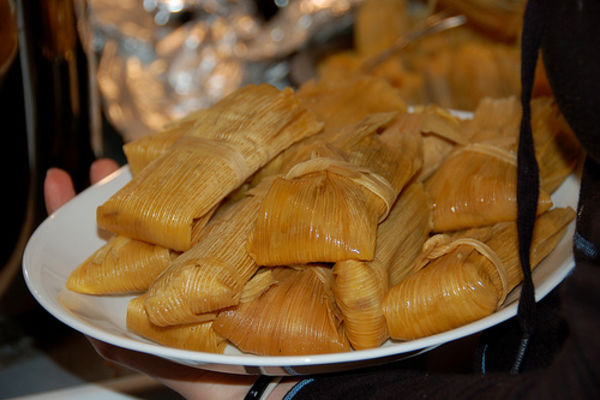Ana’s Kitchen: How to Make a Tamale (or a Hundred)
August 10, 2011
This is the second post in a series following Kiva borrower Ana Victoria. For the first post, and a look at the fine art of cooking quimbolitos, check out “Ana’s Kitchen: A Cooking Lesson in Quimbolitos.”
“The stove, the gas, the vegetables, the meat, the pots, and tools, clean water… I have a lot of expenses in my business.” Not to mention the considerable time and energy that la Doña Ana Victoria expends making a batch of her delicious tamales. Though she has many costs, Ana makes a fairly steady stream of profits from her market stall. To cover certain start-up costs and her side-business raising pigs, Ana has been lending from Kiva’s Field Partner Fundación ESPOIR for years.
Like most women in Ecuador, Ana Victoria learned how to cook from her mother, who learned it from her mother, and so on. But from here, Ana Victoria is a departure from the norm. Ana is the first woman in her family to make a business out of her cooking. Through business trainings from Fundación ESPOIR and several years’ experience, she is now running a successful micro-business. But there’s more to gain from this shift than profits: Ana Victoria will teach her daughter how to run a business, and she’ll teach her daughter, and so on. Ana’s micro-loan marks a permanent change in the role women will play in her family.
Ana Victoria’s business savvy is unmistakable (after all, she had a loyal customer in me after ten minutes’ acquaintance). Like many female Kiva borrowers, Ana sells food, coffee, and soft drinks in her local market. Comedores (hot food stalls) like hers are a common sight in a South American market; a seemingly endless line of vendors sell what look like identical products, and they all try to persuade hungry customers that their food is superior to that of their neighbors’. For this reason, Ana explained to me, “you must be a saleperson, too, and convince customers to eat your food.” Ana couldn’t help mentioning that she also has a number of loyal regular customers, who know that her food is the best.
She’s not exaggerating: if you ever go to Ecuador, I suggest the first meal you eat includes a few of Ana’s tamales. You can find her market stall on Wednesdays, Saturdays and Sundays in the small town of Cumbre outside of Cuenca. But be warned, they may also be the last meal you eat, because you’ll want to eat them every day, at every moment, for the rest of your life.
So just how do you whip up a batch of Ana’s mouth-watering tamales? Here’s an abridged version of her recipe (she uses very loose terms of measurement, a cooking methodology to which I firmly subscribe), which explains how to make the tamale filling.

Assemble your ingredients: 1 somewhat clumsy Kiva Fellow, Kate Bennett; 1 patient Kiva borrower, Ana Victoria; 4 pounds of pork; 25 onions; 8 cups of peas, shelled; 8 cups of carrots, shredded; 15 hard-boiled eggs; a bucket of clean water; 5 tablespoons salt; lots of butter

Place your pork in a gigantic pot, and fill with water until the pork is just covered. Bring to a boil, and cook for at least two hours. Ana says ten is best. While the pork is cooking, prepare the rest of your ingredients. Onions should be diced as small as possible. If shredding eight cups of carrots seems like too much work, just cut them into half inch by two inch slices. Carrots and peas can be boiled or sautéed until nearly cooked. Combine all three ingredients in a saucepan with butter. Hard-boil your eggs if you haven't already.

Once you have cooked or boiled the pork until tender, wait for it to cool, and shred it up with your fingers. You can try to remove fat as you go- most people prefer less fat in their tamales- but Ana and I (and her daughter Yessica, pictured) were pretty indiscriminate. Keep the broth, you'll need it for your masa (dough)

Keep smiling, you're almost done! When all of your veggies are combined and sautéed, toss your shredded pork and eggs into the mix. You now have your tamale filling! Unfortunately, you still haven't made the dough, softened the corn husks they'll be wrapped in, or cooked the tamales in their final form. But at least you have some really delicious filling!
Kate Bennett (KF15) is thrilled to be working for the next four months in Quito, Ecuador with new Kiva field partner Fundación Alternativa. To support Fundación Alternativa in its pilot phase, check out its partner page, its recently created lending team, or its very first loans on Kiva! For more on Kate’s experiences with Fundación Alternativa or life in Ecuador, follow her work here.
PREVIOUS ARTICLE
Kiva Partners with SOCAP11 - Get 30% off tickets to SF Conference! →NEXT ARTICLE
Featured Partner: Hekima, a Partner of World Relief →















